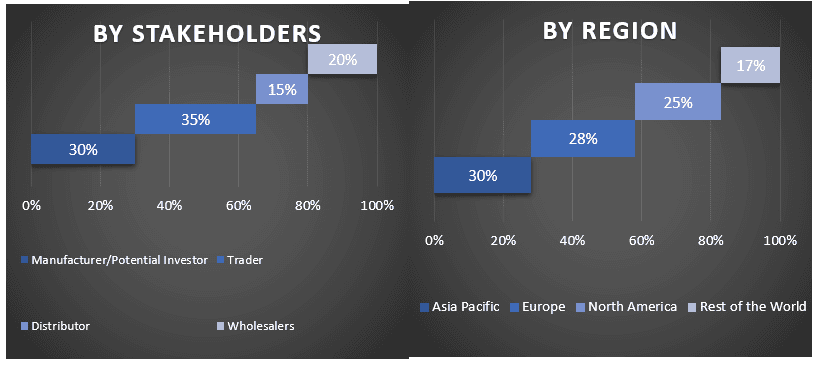- Trang chủ
- Về chúng tôi
- Ngành
- Dịch vụ
- Đọc
- Liên hệ với chúng tôi
Thị trường Xe nâng hàng Toàn cầu: Phân tích và Dự báo Hiện tại (2023-2030)
Nhấn mạnh vào Phân loại (Loại 1, Loại 2, Loại 3 và Loại 4/5); Khả năng Tải (Dưới 5 Tấn, 5-10 Tấn, 11-36 Tấn và Trên 36 Tấn); Nguồn Điện (ICE và Điện); Ứng dụng (Xây dựng, Công nghiệp, Hậu cần và các ứng dụng khác); và Khu vực/Quốc gia.

Xe nâng hàng Thị trường có giá trị 57 tỷ USD dự kiến sẽ tăng trưởng với tốc độ CAGR khoảng 8% trong giai đoạn dự báo (2023-2030).Ngành xây dựng đang mở rộng trên toàn cầu sẽ thúc đẩy nhu cầu về xe nâng hàng mạnh mẽ, có thể được sử dụng trong môi trường khắc nghiệt ngoài trời. Một số tổ chức chính phủ đang tập trung vào việc thúc đẩy cơ sở hạ tầng hiện có để phát triển kinh tế tổng thể.Ví dụ, vào tháng 5 năm 2023, Chính phủ Nam Phi dự kiến sẽ chi 56 tỷ USD (900 tỷ R) vào năm 2027 cho cơ sở hạ tầng giao thông vận tải của đất nước. Các dự án xây dựng quy mô lớn như vậy sẽ thúc đẩy nhu cầu về xe nâng hàng, đảm bảo việc chuyển giao nhanh chóng các vật liệu nặng.Thị trường thương mại điện tử đã chứng kiến sự tăng trưởng khi mọi người thích mua sắm trực tuyến để giảm tình trạng quá đông trong các cửa hàng bán lẻ và đảm bảo giãn cách xã hội. Điều này sẽ thúc đẩy nhu cầu về xe nâng hàng từ lĩnh vực thương mại điện tử, vì các nhà bán lẻ trực tuyến sử dụng xe nâng hàng chất lượng cao trong các cơ sở phân phối để hợp lý hóa các hoạt động xử lý vật liệu. Nếu thương mại điện tử bùng nổ và số lượng gói hàng được vận chuyển ngày càng tăng, ngành hậu cần sẽ tiếp tục tăng trưởng.Theo ước tính, ngành hậu cần toàn cầu có giá trị hơn 9 nghìn tỷ USD.Trong thời gian gần đây, sự tăng trưởng đáng kể đã được quan sát thấy do nhu cầu về thiết bị xử lý vật liệu hiện đại. Xe nâng hàng được sử dụng để nâng vật liệu và được sử dụng để theo dõi và theo dõi hiệu suất của người vận hành và giám sát các hệ thống cơ khí và điện. Do đó, với việc áp dụng công nghệ tiên tiến, có những cơ hội thị trường đáng kể, nhờ những nỗ lực của các nhà sản xuất trong việc sản xuất các xe tải này được điều khiển bằng công nghệ.
Một số người chơi chính hoạt động trên thị trường bao gồm Komatsu; MITSUBISHI HEAVY INDUSTRIES, LTD.; Jungheinrich AG; Hyundai Heavy Industries; Toyota Material Handling; KION Group AG; Hyster-Yale Material Handling Inc.; Crown Equipment Corporation; Anhui Heli Co., Ltd.; CLARK. Một số M&A cùng với quan hệ đối tác đã được thực hiện bởi những người chơi này để thúc đẩy sự hiện diện của họ ở các khu vực khác nhau.
Thông tin chi tiết được trình bày trong Báo cáo
“Trong số Phân loại, phân khúc loại 2 chiếm lĩnh thị trường với thị phần lớn nhất vào năm 2022”
Dựa trên Phân loại, thị trường được phân chia thành Loại 1, Loại 2, Loại 3 và Loại 4/5. Phân khúc loại 2 chiếm lĩnh thị trường với thị phần lớn nhất vào năm 2022. Sự tăng trưởng này là do số lượng cơ sở lưu trữ & kho hàng ngày càng tăng. Xe nâng hàng loại 2 là các mẫu xe điện, lối đi hẹp. Hơn nữa, xe nâng hàng loại 2 được thiết kế với khả năng cơ động cho phép chúng hoạt động trong không gian chật hẹp & lối đi hẹp. Hơn nữa, đến năm 2030, phân khúc loại 3 có khả năng sẽ thống trị thị trường do nhu cầu ngày càng tăng từ các kho hàng vừa và nhỏ để dỡ và xếp hàng vật liệu.
“Trong số Khả năng Tải, phân khúc 5-10 tấn chiếm thị phần lớn nhất vào năm 2022”
Dựa trên khả năng tải, thị trường được phân chia thành dưới 5 tấn, 5-10 tấn, 11-36 tấn và trên 36 tấn. Phân khúc 5-10 tấn chiếm thị phần lớn nhất vào năm 2022. Những xe nâng hàng này được sử dụng để xử lý nhiều loại vật liệu, bao gồm thép, pallet và gạch. Sự tăng trưởng của phân khúc này là do sự phát triển của các lĩnh vực công nghiệp, bao gồm kho bãi & hậu cần và sản xuất. Những xe nâng hàng này có thể được sử dụng trong nhà hoặc ngoài trời và được cung cấp nhiên liệu bằng khí tự nhiên, khí propan lỏng hoặc xăng.
Phạm vi Báo cáo Thị trường Xe nâng hàng

“Châu Á Thái Bình Dương dự kiến sẽ dẫn đầu thị trường xe nâng hàng trong giai đoạn dự báo”
Châu Á Thái Bình Dương dự kiến sẽ dẫn đầu thị trường xe nâng hàng trong giai đoạn dự báo. Do sự gia tăng xu hướng của các nhà sản xuất đối với tự động hóa nhà máy. Hơn nữa, việc tăng cường đầu tư R&D để phát triển các loại ô tô mới, môi trường kinh tế thuận lợi và nhu cầu về những tiến bộ công nghệ trong hậu cần nội bộ cũng đang giúp thúc đẩy tăng trưởng thị trường trong khu vực này. Tăng trưởng trong khu vực cũng được thúc đẩy bởi nhu cầu về thiết bị xử lý vật liệu hiện đại trong các ngành như xây dựng, khai thác mỏ, thực phẩm và đồ uống. Ngoài ra, việc triển khai các phương tiện am hiểu công nghệ trong khu vực đã thu hút sự quan tâm tối đa và đang bổ sung cho sự tăng trưởng của ngành xe tải.Ví dụ, vào tháng 6 năm 2022, Mitsubishi Logisnext đã ra mắt xe nâng hàng điện khí nén 4 bánh dòng MX2 và MXL với công suất 5.000-7.000 và 9.000-12.000 lb.
Lý do để mua báo cáo này:
- Nghiên cứu bao gồm phân tích định cỡ và dự báo thị trường được xác thực bởi các chuyên gia trong ngành chủ chốt.
- Báo cáo trình bày một bản xem nhanh về hiệu suất tổng thể của ngành trong nháy mắt.
- Báo cáo bao gồm phân tích chuyên sâu về các đối tác trong ngành nổi bật với trọng tâm chính là tài chính kinh doanh chính, danh mục sản phẩm, chiến lược mở rộng và sự phát triển gần đây.
- Phân tích chi tiết về các động lực, hạn chế, xu hướng chính và cơ hội thịnh hành trong ngành.
- Nghiên cứu bao gồm toàn diện thị trường trên các phân khúc khác nhau.
- Phân tích cấp độ khu vực chuyên sâu về ngành.
Tùy chọn Tùy chỉnh:
Thị trường xe nâng hàng có thể được tùy chỉnh hơn nữa theo yêu cầu hoặc bất kỳ phân khúc thị trường nào khác. Bên cạnh đó, UMI hiểu rằng bạn có thể có nhu cầu kinh doanh riêng, do đó, đừng ngần ngại kết nối với chúng tôi để có được một báo cáo hoàn toàn phù hợp với yêu cầu của bạn.
Mục lục
Phương pháp Nghiên cứu để Phân tích Thị trường Xe nâng hàng (2023-2030)
Phân tích thị trường lịch sử, ước tính thị trường hiện tại và dự báo thị trường tương lai của thị trường xe nâng hàng là ba bước chính được thực hiện để tạo và phân tích việc áp dụng xe nâng hàng ở các khu vực chính trên toàn cầu. Nghiên cứu thứ cấp toàn diện đã được thực hiện để thu thập số liệu thị trường lịch sử và ước tính quy mô thị trường hiện tại. Thứ hai, để xác thực những hiểu biết này, nhiều phát hiện và giả định đã được xem xét. Hơn nữa, các cuộc phỏng vấn chính toàn diện cũng đã được thực hiện, với các chuyên gia trong ngành trên toàn bộ chuỗi giá trị của thị trường xe nâng hàng. Sau khi giả định và xác thực số liệu thị trường thông qua các cuộc phỏng vấn chính, chúng tôi đã sử dụng phương pháp từ trên xuống/từ dưới lên để dự báo quy mô thị trường hoàn chỉnh. Sau đó, các phương pháp phân tích và tam giác hóa dữ liệu thị trường đã được áp dụng để ước tính và phân tích quy mô thị trường của các phân khúc và phân khúc phụ của ngành liên quan. Phương pháp chi tiết được giải thích dưới đây:
Phân tích Quy mô Thị trường Lịch sử
Bước 1: Nghiên cứu chuyên sâu về các Nguồn thứ cấp:
Nghiên cứu thứ cấp chi tiết đã được tiến hành để có được quy mô thị trường lịch sử của thị trường xe nâng hàng thông qua các nguồn nội bộ của công ty nhưbáo cáo thường niên & báo cáo tài chính, bài thuyết trình hiệu suất, thông cáo báo chí, v.v.và các nguồn bên ngoài bao gồmtạp chí, tin tức & bài viết, ấn phẩm chính phủ, ấn phẩm của đối thủ cạnh tranh, báo cáo ngành, cơ sở dữ liệu của bên thứ ba và các ấn phẩm đáng tin cậy khác.
Bước 2: Phân khúc Thị trường:
Sau khi có được quy mô thị trường lịch sử của thị trường xe nâng hàng, chúng tôi đã tiến hành phân tích thứ cấp chi tiết để thu thập thông tin chi tiết về thị trường lịch sử và chia sẻ cho các phân khúc & phân khúc phụ khác nhau cho các khu vực chính. Các phân khúc chính được bao gồm trong báo cáo là phân loại, khả năng tải, nguồn điện và ứng dụng. Phân tích cấp quốc gia hơn nữa đã được thực hiện để đánh giá việc áp dụng tổng thể các mô hình thử nghiệm trong khu vực đó.
Bước 3: Phân tích Yếu tố:
Sau khi có được quy mô thị trường lịch sử của các phân khúc và phân khúc phụ khác nhau, chúng tôi đã tiến hành mộtphân tích yếu tốchi tiết để ước tính quy mô thị trường hiện tại của thị trường xe nâng hàng. Hơn nữa, chúng tôi đã tiến hành phân tích yếu tố bằng cách sử dụng các biến phụ thuộc và độc lập như phân loại, khả năng tải, nguồn điện và ứng dụng của thị trường xe nâng hàng. Một phân tích kỹ lưỡng đã được tiến hành cho các kịch bản cung và cầu có tính đến các quan hệ đối tác hàng đầu, sáp nhập và mua lại, mở rộng kinh doanh và ra mắt sản phẩm trong lĩnh vực thị trường xe nâng hàng trên toàn cầu.
Ước tính và Dự báo Quy mô Thị trường Hiện tại
Định cỡ Thị trường Hiện tại:Dựa trên những thông tin chi tiết có thể hành động từ 3 bước trên, chúng tôi đã xác định được quy mô thị trường hiện tại, các đối tượng chính trên thị trường xe nâng và thị phần của các phân khúc. Tất cả các tỷ lệ phần trăm phân chia và phân tích thị trường cần thiết đều được xác định bằng cách sử dụng phương pháp thứ cấp đã đề cập ở trên và đã được xác minh thông qua các cuộc phỏng vấn chính.
Ước tính & Dự báo:Để ước tính và dự báo thị trường, trọng số đã được gán cho các yếu tố khác nhau bao gồm động lực & xu hướng, hạn chế và cơ hội dành cho các bên liên quan. Sau khi phân tích các yếu tố này, các kỹ thuật dự báo có liên quan, tức là phương pháp từ trên xuống/từ dưới lên, đã được áp dụng để đưa ra dự báo thị trường cho năm 2030 cho các phân khúc và phân đoạn phụ khác nhau trên các thị trường lớn trên toàn cầu. Phương pháp nghiên cứu được áp dụng để ước tính quy mô thị trường bao gồm:
- Quy mô thị trường của ngành, tính theo doanh thu (USD) và tỷ lệ áp dụng của thị trường xe nâng trên các thị trường lớn trong nước
- Tất cả các tỷ lệ phần trăm, phân chia và phân tích của các phân khúc và phân đoạn phụ của thị trường
- Các đối tượng chính trên thị trường xe nâng về sản phẩm được cung cấp. Ngoài ra, các chiến lược tăng trưởng được các đối tượng này áp dụng để cạnh tranh trong thị trường phát triển nhanh chóng
Xác nhận Quy mô và Thị phần Thị trường
Nghiên cứu Sơ cấp:Các cuộc phỏng vấn chuyên sâu đã được tiến hành với các Nhà lãnh đạo Ý kiến Chính (KOL) bao gồm các Giám đốc điều hành cấp cao (CXO/VP, Trưởng phòng Kinh doanh, Trưởng phòng Tiếp thị, Trưởng phòng Vận hành, Trưởng phòng Khu vực, Trưởng phòng Quốc gia, v.v.) trên các khu vực chính. Các phát hiện nghiên cứu chính sau đó đã được tóm tắt và phân tích thống kê đã được thực hiện để chứng minh các giả thuyết đã nêu. Đầu vào từ nghiên cứu sơ cấp đã được hợp nhất với các phát hiện thứ cấp, do đó chuyển đổi thông tin thành thông tin chi tiết có thể hành động.
Phân chia Người tham gia Sơ cấp ở các Khu vực Khác nhau

Kỹ thuật Thị trường
Kỹ thuật tam giác dữ liệu đã được sử dụng để hoàn thành việc ước tính thị trường tổng thể và đưa ra các con số thống kê chính xác cho từng phân khúc và phân đoạn phụ của thị trường xe nâng. Dữ liệu được chia thành một số phân khúc & phân đoạn phụ sau khi nghiên cứu các thông số và xu hướng khác nhau trong các lĩnh vực loại, khả năng tải, nguồn điện và ứng dụng trong thị trường xe nâng.
Mục tiêu Chính của Nghiên cứu Thị trường Xe nâng Toàn cầu
Các xu hướng thị trường hiện tại & tương lai của thị trường xe nâng toàn cầu đã được xác định trong nghiên cứu. Các nhà đầu tư có thể thu được những hiểu biết chiến lược để dựa vào sự cân nhắc của họ đối với các khoản đầu tư vào phân tích định tính và định lượng được thực hiện trong nghiên cứu. Các xu hướng thị trường hiện tại và tương lai xác định sức hấp dẫn tổng thể của thị trường ở cấp độ khu vực, cung cấp một nền tảng cho người tham gia công nghiệp khai thác thị trường chưa được khai thác để hưởng lợi từ lợi thế đi đầu. Các mục tiêu định lượng khác của các nghiên cứu bao gồm:
- Phân tích quy mô thị trường hiện tại và dự báo của thị trường xe nâng tính theo giá trị (USD). Ngoài ra, phân tích quy mô thị trường hiện tại và dự báo của các phân khúc và phân đoạn phụ khác nhau
- Các phân khúc trong nghiên cứu bao gồm các lĩnh vực loại, khả năng tải, nguồn điện và ứng dụng.
- Định nghĩa và phân tích khuôn khổ pháp lý cho ngành xe nâng
- Phân tích chuỗi giá trị liên quan đến sự hiện diện của các trung gian khác nhau, cùng với việc phân tích hành vi của khách hàng và đối thủ cạnh tranh của ngành
- Phân tích quy mô thị trường hiện tại và dự báo của thị trường xe nâng cho khu vực chính
- Các quốc gia chính của các khu vực được nghiên cứu trong báo cáo bao gồm Châu Á Thái Bình Dương, Châu Âu, Bắc Mỹ và Phần còn lại của Thế giới
- Hồ sơ công ty của thị trường xe nâng và các chiến lược tăng trưởng được những người chơi trên thị trường áp dụng để duy trì trong thị trường phát triển nhanh chóng
Phân tích chuyên sâu cấp khu vực của ngành
Liên quan Báo cáo
Khách hàng đã mua mặt hàng này cũng đã mua










